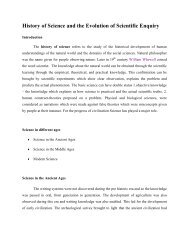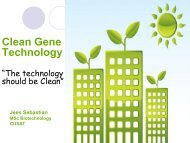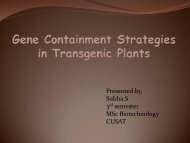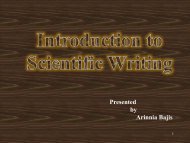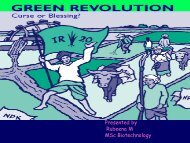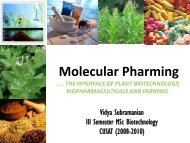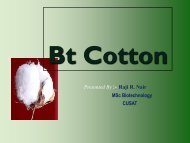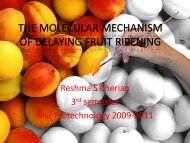gmo regulations in india - (CUSAT) â Plant Biotechnology laboratory
gmo regulations in india - (CUSAT) â Plant Biotechnology laboratory
gmo regulations in india - (CUSAT) â Plant Biotechnology laboratory
You also want an ePaper? Increase the reach of your titles
YUMPU automatically turns print PDFs into web optimized ePapers that Google loves.
GMO REGULATIONS ININDIACikesh P.CMicrobial Technology LaboratoryDept.of <strong>Biotechnology</strong><strong>CUSAT</strong>
• Rules for the manufacture, use/import/export andstorage of hazardous microorganisms/ geneticallyeng<strong>in</strong>eered organisms or cells, 1989 notified bythe M<strong>in</strong>istry of Environment & Forests,Government of India under EnvironmentalProtection Act (1986)• It demands constitution of an InstitutionalBiosafety Committee (IBSC) by everyorganization engaged <strong>in</strong> research and productionactivities related to GMOs
Department of <strong>Biotechnology</strong> guidel<strong>in</strong>es "Recomb<strong>in</strong>ant DNA Safety Guidel<strong>in</strong>es" (1990DBT Guidel<strong>in</strong>es)"Revised Guidel<strong>in</strong>es for Safety <strong>in</strong><strong>Biotechnology</strong>" (1994 DBT Guidel<strong>in</strong>es)1998 "Revised Guidel<strong>in</strong>es for Research <strong>in</strong>Transgenic <strong>Plant</strong>s and Guidel<strong>in</strong>es for Toxicity andAllergenicity Evaluation of Transgenic Seeds,<strong>Plant</strong>s and <strong>Plant</strong> Parts" (1998 DBT Guidel<strong>in</strong>es).
• The 1990 and 1994 DBT guidel<strong>in</strong>esrecommend appropriate practices,equipments and facilities necessary forsafeguards <strong>in</strong> handl<strong>in</strong>g GMOs <strong>in</strong> agriculture andpharmaceutical sectors• These guidel<strong>in</strong>es cover‣ R&D activities on GMOs‣ Transgenic crops‣ Large-scale production and deliberaterelease of GMOs‣ <strong>Plant</strong>s, animals and products <strong>in</strong>to theenvironment‣ Shipment and importation of GMOs for<strong>laboratory</strong> research
• 1998 DBT guidel<strong>in</strong>es cover areas ofrecomb<strong>in</strong>ant DNA research on plants The development transgenic plants and theirgrowth <strong>in</strong> soil for molecular and field evolution The toxicity and allergenicity data forrum<strong>in</strong>ants such as goats and cows, fromconsumption of transgenic plantsData on comparative economic benefits of amodified plant
• Government of India established a three-tierregulatory structure at the central level <strong>in</strong> NewDelhi compris<strong>in</strong>g three committees-The Review Committee on GeneticManipulation (RCGM) under the M<strong>in</strong>istry ofScience and Technology (MoST);The Genetic Eng<strong>in</strong>eer<strong>in</strong>g ApprovalCommittee (GEAC) under the M<strong>in</strong>istry ofEnvironment and Forestry (MoEF);The Monitor<strong>in</strong>g and Evaluation Committee(MEC) under DBT/MoST
• DBT provides the secretariat for RCGM and MEC,and the MoEF for GEAC.• The GoI setted up a de-centralised structureconsist<strong>in</strong>g of Institutional BiosafetyCommittees (IBSCs) andState and DistrictLevel Committees (SBCCs and DLCs)• IBSCs have been established <strong>in</strong> all <strong>in</strong>stitutions(public and private) that deal with GMOs• By 2008, only three states (out of a total of twentyfivestates and several „union territories‟ that makeup the Indian Union) had created SBCCs• DLCs have not been set up anywhere
• RCGM (Review Committee on GeneticManipulation)‣ assess and decide on the applicationssubmitted by <strong>in</strong>stitutions and companies forconduct<strong>in</strong>g R&D work,‣ greenhouse tests and conta<strong>in</strong>ed field tests onplots of less than one acre <strong>in</strong> size (0.4hectare)Institutions and companies wish<strong>in</strong>g to proceedbeyond these stages towards general release andcommercialisation of GM-crops must conductlarge-scale and multi-location field trials that aremandatory under the biosafety <strong>regulations</strong>
GEAC (Genetic Eng<strong>in</strong>eer<strong>in</strong>g ApprovalCommittee)• Has the sole responsibility and power toauthorise large-scale and multi-location fieldtrials• It can asses the „output‟ of the trials and on thebasis of that assessment to approve, reject orput on hold the applicant’s request for generalrelease of the GM-crop for commercial plant<strong>in</strong>g,impos<strong>in</strong>g conditions (if need be) under which thegeneral release can take place• GEAC may request ICAR to check and validate the´output‟ of the field trials submitted by theapplicant, if necessary by conduct<strong>in</strong>g its own fieldtrials.
MEC (Monitor<strong>in</strong>g and Evaluation Committee)• Monitors the small-scale conta<strong>in</strong>ed field tests(RCGM’s ambit) and the open larger-scalefield trials (GEAC’s sphere), and submits itsreports to RCGM• MEC‟s monitor<strong>in</strong>g work and reports are expected tocover all the ma<strong>in</strong> aspects of biosafety The impact of the GM-crop on theenvironment (ecology and biodiversity)The agronomy (crop production science andfarm-level economy)The health of humans and livestock and thelivelihoods of the farm<strong>in</strong>g community
IBSC constitution• (i) Head of the Institution or nom<strong>in</strong>ee• (ii) 3 or more scientists engaged <strong>in</strong> rDNA work ormolecular biology with an outside expert <strong>in</strong> therelevant discipl<strong>in</strong>e.• (iii) A member with medical qualifications -Biosafety Officer (<strong>in</strong> case of work with pathogenicagents/large scale use).• (iv) A nom<strong>in</strong>ee of DBT.
• Every <strong>in</strong>stitution sett<strong>in</strong>g up an IBSC first needsto identify the members-• The request has to be submitted to DBT alongwith the list and background of the proposedmembers• DBT then identifies an appropriate nom<strong>in</strong>ee andcommunicates the same to IBSC chairman.
• If research is conducted on organisms that requirespecial conta<strong>in</strong>ment conditions (Biosafety Level 3or 4) or if large-scale microbial research isconducted, a Biological Safety Officer must beappo<strong>in</strong>ted.• His responsibilities <strong>in</strong>clude periodic <strong>in</strong>spection offacilities and protocols and development ofemergency plan, as higher conta<strong>in</strong>ment levelsrequire more scrut<strong>in</strong>y.• This person is also a member of the IBSC
IBSC MEETINGS• Each IBSC has to meet at least twice a year toreview the status of rDNA projects <strong>in</strong> the <strong>in</strong>stitution• The IBSC members are expected to look <strong>in</strong>to thefollow<strong>in</strong>g dur<strong>in</strong>g the meet<strong>in</strong>gs:‣ Action taken on the decisions of earlier IBSCmeet<strong>in</strong>gs.‣ Characterization of work and approval as per riskcategory.‣ Evaluation of projects and direction tosubmission for appropriate agencies for approvals
‣ Inspection of conta<strong>in</strong>ment facilities andgreenhouses etc.‣ Review the medical reports of employees‣ Ma<strong>in</strong>ta<strong>in</strong><strong>in</strong>g procedures and other approvalrequirements.
SUBMISSION OF REPORTS- IBSC• IBSC has to furnish half yearly reports on theongo<strong>in</strong>g projects <strong>in</strong> the organization to RCGM(Review Committee on Genetic Manipulation)• The report consists of the observance of thesafety guidel<strong>in</strong>es <strong>in</strong>clud<strong>in</strong>g accidents, risks anddeviations, if any.• There is a prescribed format for <strong>in</strong>formationon projects to IBSC/RCGM and half yearlyreports to be submitted to RCGM
FUNCTIONS- IBSC• The role of IBSCs assumes major importance <strong>in</strong>the regulatory framework s<strong>in</strong>ce it is a StatutoryCommittee that operates from the premises ofthe <strong>in</strong>stitution• It is <strong>in</strong> a position to conduct onsite evaluation,assessment and monitor<strong>in</strong>g of adherence tothe biosafety guidel<strong>in</strong>es.
• The decisions taken by the next highercommittee i.e., Review Committee on GeneticManipulation (RCGM), which operates fromDBT are based on the applications submittedby the <strong>in</strong>vestigators with the approval of IBSC• therefore, it is pert<strong>in</strong>ent that the membersof the IBSCs and DBT nom<strong>in</strong>ees to theIBSCs have expertise <strong>in</strong> evaluation,assessment and monitor<strong>in</strong>g of projectsas per the rDNA guidel<strong>in</strong>es.
• Based on the feedback received <strong>in</strong> theseconsultations, a handbook was prepared byBCIL <strong>in</strong> consultation with DBT for membersand DBT nom<strong>in</strong>ees of IBSCs cover<strong>in</strong>g thecomposition, functions, role <strong>in</strong> approval and achecklist for evaluat<strong>in</strong>g projects, which can beused on a case-to-case basis.• A CD conta<strong>in</strong><strong>in</strong>g important biosafety<strong>regulations</strong> and guidel<strong>in</strong>es for GMOs is also<strong>in</strong>cluded <strong>in</strong> the handbook for ready referenceby the IBSC members and nom<strong>in</strong>ees of DBT
• The IBSC is the nodal po<strong>in</strong>t for <strong>in</strong>teractionwith<strong>in</strong> the <strong>in</strong>stitution for implementation of thebiosafety regulatory framework• Highly def<strong>in</strong>ed roles for the committees andtheir members• Inorder to strengthen the function<strong>in</strong>g of thecommittees and their feedback to DBT, DBT <strong>in</strong>association with Biotech Consortium IndiaLimited (BCIL) organized a series of nationalconsultations at six locations namelyBangalore, Chennai, Hyderabad, New Delhi,Mumbai and Jalna
FUNCTIONS- IBSC• Head of the <strong>in</strong>stitutionthe biosafety guidel<strong>in</strong>es are followed <strong>in</strong>his <strong>in</strong>stitution.regular meet<strong>in</strong>gs of IBSC are held toreview recomb<strong>in</strong>ant research projects <strong>in</strong>the <strong>in</strong>stitution.open discussion takes place amongst themembers <strong>in</strong> the meet<strong>in</strong>gs and the views ofexternal members as well DBT nom<strong>in</strong>eerecorded.the facilities at the <strong>in</strong>stitution are sufficientto meet the conta<strong>in</strong>ment levels stipulatedfor rDNA products and processes
• IBSC members• The ma<strong>in</strong> functions of IBSC members asdef<strong>in</strong>ed <strong>in</strong> the rDNA Safety Guidel<strong>in</strong>es by DBTare as follows:Review and clearance of project proposalsfall<strong>in</strong>g under restricted category, whichfulfill the requirements under the guidel<strong>in</strong>esTailor<strong>in</strong>g biosafety programme as per thelevel of risk assessed.Tra<strong>in</strong><strong>in</strong>g of personnel on biosafety.Institut<strong>in</strong>g a health-monitor<strong>in</strong>g programmefor <strong>laboratory</strong> personnel.Adopt<strong>in</strong>g emergency plans.
• DBT Nom<strong>in</strong>eeEach IBSC has a nom<strong>in</strong>ee from DBT who oversees theactivities to ensure that safety aspects are be<strong>in</strong>g fullyadhered by the organizationThe committee has been constituted as per thenorms of the guidel<strong>in</strong>esThe Recomb<strong>in</strong>ant DNA Safety Guidel<strong>in</strong>es arestrictly followed <strong>in</strong> the <strong>in</strong>stitution.The IBSC meets regularly, at least twice <strong>in</strong> ayear to review the ongo<strong>in</strong>g activities andprovides half yearly reports to RCGM/DBT <strong>in</strong> theprescribed performa.All the activities are with<strong>in</strong> the purview of theguidel<strong>in</strong>es and <strong>in</strong> the knowledge of RCGM/DBT.The DBT nom<strong>in</strong>ee is expected to guide the IBSCon biosafety issues.
• Pr<strong>in</strong>cipal Investigator• Depend<strong>in</strong>g upon the risk category, the PI has to<strong>in</strong>form the IBSC, seek permission of IBSC beforestart<strong>in</strong>g the experiments or seek permission ofthe RCGM through its IBSC• The PI is primarily responsible for ensur<strong>in</strong>gcompliance with biosafety standards• The PI functions as a project manager as well asa researcher, communicat<strong>in</strong>g with the IBSC andbear<strong>in</strong>g responsibility for tra<strong>in</strong><strong>in</strong>g andsupervis<strong>in</strong>g personnel
• Based on the nature of the GMO, the PIdeterm<strong>in</strong>es the proper conta<strong>in</strong>ment levelfor the project and, <strong>in</strong> accordance with theDBT Guidel<strong>in</strong>es, develops the necessaryexperimental protocols.• to make an <strong>in</strong>itial determ<strong>in</strong>ation of therequired levels of physical and biologicalconta<strong>in</strong>ment <strong>in</strong> accordance with the DBTguidel<strong>in</strong>es.
to submit the <strong>in</strong>itial research protocol andany subsequent changes (such as changes <strong>in</strong>the source of DNA or host vector system) tothe IBSC for review and approval.to ensure that no work is <strong>in</strong>itiated until theresearch project has been approved by the IBSCand has met all requirements of DBT guidel<strong>in</strong>es.rema<strong>in</strong> <strong>in</strong> communication with the IBSCthroughout the conduct of the project.To ensure the safe conduct of the rDNAexperiments <strong>in</strong> his <strong>laboratory</strong>.
To make available the protocols that describethe potential biohazards and the precautions tobe taken to all <strong>laboratory</strong> staff.To <strong>in</strong>struct <strong>laboratory</strong> staff about the practicesand techniques required to ensure safety, andthe procedures for deal<strong>in</strong>g with accidents.To supervise the performance of the <strong>laboratory</strong>staff to ensure that the required safety practicesand techniques are employed.To undertake corrective measures promptly forany work errors and conditions that may result<strong>in</strong> the release of recomb<strong>in</strong>ant DNA materials.
ROLE OF IBSC IN APPROVAL• The rDNA activities with<strong>in</strong> an organizationcould be broadly categorizedresearchlarge-scaleexperiments/production/field releaseimport and shipment
Research• IBSC has to review all recomb<strong>in</strong>ant researchcarried out by an organization• The rDNA Safety Guidel<strong>in</strong>es of DBT stipulatethree categories of research activities i.e.Category I, II and III with <strong>in</strong>creas<strong>in</strong>g level ofconta<strong>in</strong>ment requirements• Category I experiments <strong>in</strong>volv<strong>in</strong>g self clon<strong>in</strong>g,us<strong>in</strong>g stra<strong>in</strong>s and also <strong>in</strong>ter species clon<strong>in</strong>gbelong<strong>in</strong>g to organism <strong>in</strong> the same exchangergroup etc. and are exempt for the purpose of<strong>in</strong>timation and approval.
• Category II experiments fall<strong>in</strong>g underconta<strong>in</strong>ment levels II, III and IV, large scale useof recomb<strong>in</strong>ants made of self clon<strong>in</strong>g <strong>in</strong> systemsbelong<strong>in</strong>g to exempt category etc. require prior<strong>in</strong>timation to IBSC• Category III experiments <strong>in</strong>volv<strong>in</strong>g tox<strong>in</strong> geneclon<strong>in</strong>g, clon<strong>in</strong>g of genes for vacc<strong>in</strong>e production,use of <strong>in</strong>fectious animals and plant viruses, selffusion experiments, field test<strong>in</strong>g and release etc.require review and approval of IBSC beforecommencement• Depend<strong>in</strong>g upon the category of experiments,IBSC can simply note the <strong>in</strong>formation provided byPI, give permission before start of theexperiments or forward it to RCGM for approval.
• The categories of genetic eng<strong>in</strong>eer<strong>in</strong>gexperiments on plants have been notifiedspecifically under the “Revised Guidel<strong>in</strong>es forResearch <strong>in</strong> Transgenic <strong>Plant</strong>, 1998” by DBT• In this categorization, rout<strong>in</strong>e recomb<strong>in</strong>ant DNAexperiments fall <strong>in</strong> Category I and need only<strong>in</strong>timation to the IBSC• Category II <strong>in</strong>clude lab and greenhouseexperiments <strong>in</strong> conta<strong>in</strong>ed environment wheredef<strong>in</strong>ed DNA fragments that are non pathogenicto human and animals are used for genetictransformation of plants
• Category III perta<strong>in</strong>s to high risk experimentswhere the escape of transgenic traits <strong>in</strong>to theopen environment could cause significantalterations <strong>in</strong> the biosphere, the ecosystem,the plants and animals.• All experiments conducted <strong>in</strong> greenhouse andopen field conditions not belong<strong>in</strong>g to theabove Category II types, would fall underCategory III risks• Such experiments could be conducted onlyafter clearance from RCGM and notified by theDepartment of <strong>Biotechnology</strong>
• Different levels of conta<strong>in</strong>ment have beenprescribed for different categories of rDNAexperiments <strong>in</strong> the guidel<strong>in</strong>es• IBSC should allow genetic eng<strong>in</strong>eer<strong>in</strong>g activityon classified organisms only at places wheresuch work should be performed as perguidel<strong>in</strong>es• Provision of suitable safe storage facility ofdonor, vectors, recipients and other materials<strong>in</strong>volved <strong>in</strong> experimental work should be madeand may be subject to <strong>in</strong>spection onaccountability.
Large scale trials and production• approval for large-scale trials and productionneeds to be taken from GEAC, as per the Rules1989• IBSC has an extremely important role <strong>in</strong> termsof verify<strong>in</strong>g the <strong>in</strong>formation be<strong>in</strong>g forwarded toRCGM and GEAC• Both RCGM and GEAC depend on the review ofthe IBSC on the submissions made.• IBSC has to recommend emergency plan <strong>in</strong>case of large-scale operations <strong>in</strong>clud<strong>in</strong>gmethods and procedures for handl<strong>in</strong>g largelosses of cultures and organisms
• The <strong>in</strong>terstate shipment of <strong>in</strong>digenousetiological agents, diagnostic specimens andbiological products need clearance of IBSC• The import of regulated materials forresearch (e.g. tox<strong>in</strong> genes, hybridomas, cellcultures, organelle) and specify<strong>in</strong>gconditions under which the agent or vector isshipped, handled and use are issued by RCGM• large scale imports for <strong>in</strong>dustrial use areregulated by GEAC• In case of plants, the import is routedthrough the Director, National Bureau of<strong>Plant</strong> Genetic Resources on the basis of theimport permit issued by the DBT, based onrecommendations of the RCGM
Information required for risk assessment of a GMOParticularsMolecular Biology DetailsCharacteristics of donor organismsCharacteristics of host/ recipientorganismsInformation requiredOrig<strong>in</strong>/source and taxonomicclassificationGenome characteristics and priorhistory for genetic manipulationNature of pathogenicity and virulence,<strong>in</strong>fectivity or toxicity, its host range andstability of these traitsTechniques for identification of donororganismOrig<strong>in</strong>/source and taxonomicclassificationGenome characteristics and priorhistory for genetic manipulation,cultivation/growth and safe useInformation on reproductive cycle(asexual/sexual), its growth andsurvivalNature of pathogenicity and virulence,<strong>in</strong>fectivity or toxicity, its host range andstability of these traits
Characteristics oftransformed/modified organismGenotypic characters <strong>in</strong>clud<strong>in</strong>gcharacterization of site ofmodification of recipient genome,regulation and stability of <strong>in</strong>sertedDNA, frequency of mobilization of<strong>in</strong>serted DNA and/ or genetic transfercapabilityPhenotypic characters <strong>in</strong>clud<strong>in</strong>gtaxonomic characterization,colonization potential, antibioticresistance, <strong>in</strong>fectivity, production oftox<strong>in</strong>s, allergens, ant<strong>in</strong>utrients or anyother metabolites and its host rangeExpression and properties of thegene product <strong>in</strong>clud<strong>in</strong>g copies/number of new gene(s), rate andlevel of expression, activity ofexpressed prote<strong>in</strong>, allergenic/toxichazards of the product
Human HealthConsiderationsToxicity• For human food/animal feed,elaborate determ<strong>in</strong>ation of compositionand assessment of quality oftransformed plants/fruits/seeds aswell as animals, with appropriatecontrolsAllergenicity• Comparison of the characteristicsof the modified organism to therecipient organism regard<strong>in</strong>gallergenicity• Composition analysis of all major<strong>in</strong>gredients <strong>in</strong> GMOsNutritional analysis•Changes <strong>in</strong> the level of key nutrients,natural toxicants or anti nutrients,bioavailability of nutrients.
Environmental ConsiderationsApplication of the modified organism<strong>in</strong> the environment-Geographical location site-Conta<strong>in</strong>ment and decontam<strong>in</strong>ation-Introduction protocols <strong>in</strong>clud<strong>in</strong>gquantity and frequency of application-Methods for monitor<strong>in</strong>g applications- Other <strong>in</strong>clud<strong>in</strong>g transportarrangements, post-releasemonitor<strong>in</strong>g of the site, impact of GMOon weed formationSurvival, multiplication anddissem<strong>in</strong>ation of the GMO <strong>in</strong> the largescale facilities/field/environment-Description of detection,identification and monitor<strong>in</strong>gtechniques-Specificity, sensitivity and reliabilityof detection techniques-Study of gene flow <strong>in</strong> plants-Implications of out cross<strong>in</strong>g/crossfertilization
Interactions of modified organismswith biological systems (target andnon-target populations)-Known and predicted habitats of theGMO-Identification and description oftarget organisms and ecosystems-Identification and description of nontargetorganism(s) which might beexposedStability of the GMO <strong>in</strong> terms ofgenetic traits-Genetic transfer capability-Likelihood of post-release selectionlead<strong>in</strong>g to the expression ofunexpected and undesirable traits bythe modified organismRoutes of dissem<strong>in</strong>ation-Routes of dissem<strong>in</strong>ation, physical orbiological- Known or potential modes of<strong>in</strong>teraction, <strong>in</strong>clud<strong>in</strong>g <strong>in</strong>halation,<strong>in</strong>gestion, surface contact, burrow<strong>in</strong>gand <strong>in</strong>jection
Characteristics of the purifiedproducts from GMOs (e.g.:recomb<strong>in</strong>ant therapeutics)- Identity, strength, quality, purity-Evaluation of functional assays<strong>in</strong>clud<strong>in</strong>g potency of active component,sensitivity, specificity, variability ofassays-Estimates of variability <strong>in</strong>clud<strong>in</strong>g upperand lower limits for each specificationfor f<strong>in</strong>al release of the product- If purified product is held prior tofurther process<strong>in</strong>g, <strong>in</strong>formation ondescription of storage conditions andverification of stability
Categorization of microorganisms based on pathogenicityHazard Group 1Hazard Group 2Organisms that are most unlikely to cause human diseaseOrganisms capable of caus<strong>in</strong>g human disease and which may bea hazard to <strong>laboratory</strong> workers, but are unlikely to spread to thecommunity. Laboratory exposure rarely produces <strong>in</strong>fection andeffective prophylaxis or effective treatment is usually availableHazard Group 3Hazard Group 4Organisms that may cause severe human disease and present aserious hazard to <strong>laboratory</strong> workers. They may present a risk ofspread to the community, but there is usually effective prophylaxisor treatment availableOrganisms that cause severe human disease and are a serioushazard to <strong>laboratory</strong> workers. They may present a high risk ofspread to the community, and there is usually no effectiveprophylaxis or treatment
BiosafetyLevelPractice and Techniques Safety Facilities1. Standard microbiological practices Non primary conta<strong>in</strong>ment providedby adherence to standard <strong>laboratory</strong>practicesBasic2. Level 1 practices plus <strong>laboratory</strong>coats; decontam<strong>in</strong>ation of all<strong>in</strong>fectious wastes limited access;protective gloves and biohazardwarn<strong>in</strong>g signs as <strong>in</strong>dicated3. Level 2 practice plus special<strong>laboratory</strong> cloth<strong>in</strong>g, controlledaccess4. Level 3 practices plus entrancethrough change room where streetcloth<strong>in</strong>g is removed and <strong>laboratory</strong>cloth<strong>in</strong>g is put on shower on exit,all wastes are decontam<strong>in</strong>ated onPartial conta<strong>in</strong>ment equipment (i.e.Class I or II Biological SafetyCab<strong>in</strong>ets) used to conductmechanical and manipulativeprocedures that have aerosolpotential that may <strong>in</strong>crease the riskof exposure to personnelPartial conta<strong>in</strong>ment equipment usedfor all manipulations of <strong>in</strong>fectiousmaterialMaximum conta<strong>in</strong>ment equipment(i.e. class III biological safetycab<strong>in</strong>et or partial conta<strong>in</strong>mentequipment <strong>in</strong> comb<strong>in</strong>ation with fullbody air supplied, positive pressureBasic.Conta<strong>in</strong>mentMaximumconta<strong>in</strong>ment



